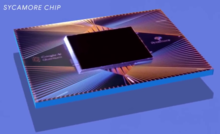Sycamore processor

Sycamore is a transmon superconducting quantum processor created by Google's Artificial Intelligence division.[1] It has 53 qubits.[2]
In 2019, Sycamore completed a task in 200 seconds that Google claimed, in a Nature paper, would take a state-of-the-art supercomputer 10,000 years to finish. Thus, Google claimed to have achieved quantum supremacy. To estimate the time that would be taken by a classical supercomputer, Google ran portions of the quantum circuit simulation on the Summit, one of the most powerful classical computers in the world.[3][4][5][6][7][8] Later, IBM made a counter-argument, claiming that the task would only take 2.5 days on a classical system like Summit.[9][10] If Google's claims are upheld, then it would represent an exponential leap in computing power.[11][12][13]
In August 2020, quantum engineers working for Google reported the largest chemical simulation on a quantum computer – a Hartree–Fock approximation with Sycamore paired with a classical computer that analyzed results to provide new parameters for the 12-qubit system.[14][15][16]
In April 2021, researchers working with Sycamore reported that they were able to realize the ground state of the toric code, a topologically ordered state, with 31 qubits. They showed long-range entanglement properties of the state by measuring non-zero topological entropy, simulating anyon interferometry and their braiding statistics, and preparing a topological quantum error correcting code with one logical qubit.[17]
In July 2021, a collaboration consisting of Google and multiple universities reported the observation of a discrete time crystal on the Sycamore processor. The chip of 20 qubits was used to obtain a many-body localization configuration of up and down spins. The configuration was stimulated with a laser to achieve a periodically driven "Floquet" system where all up spins are flipped for down and vice versa in periodic cycles which are multiples of the laser's cycles. No energy was absorbed from the laser so the system remained in a protected eigenstate order.[18][19]
In 2022, the Sycamore processor was used to simulate traversable wormhole dynamics.[20]
The German Forschungszentrum Jülich cooperated with Google in developing the Sycamore quantum computer, and it will be home to the first universal quantum computer developed in Europe as part of the OpenSuperQ project.[21][22]
See also
[edit]References
[edit]- ^ Kan, Michael (23 October 2019). "Google Claims Quantum Computing Achievement, IBM Says Not So Fast". PCMAG.
- ^ Cho, Adrian (2 August 2022). "Ordinary computers can beat Google's quantum computer after all". Science.
- ^ "Summit". Retrieved 2 April 2024.
- ^ "Frontier remains world's most powerful supercomputer on Top500 list". 14 November 2023. Retrieved 2 April 2024.
- ^ Arute, Frank; Arya, Kunal; Babbush, Ryan; Bacon, Dave; Bardin, Joseph C.; Barends, Rami; Biswas, Rupak; Boixo, Sergio; Brandao, Fernando G. S. L.; Buell, David A.; Burkett, Brian (October 2019). "Quantum supremacy using a programmable superconducting processor". Nature. 574 (7779): 505–510. arXiv:1910.11333. Bibcode:2019Natur.574..505A. doi:10.1038/s41586-019-1666-5. ISSN 1476-4687. PMID 31645734.
- ^ Rincon, Paul (23 October 2019). "Google claims 'quantum supremacy' for computer". BBC News. Retrieved 23 October 2019.
- ^ Gibney, Elizabeth (23 October 2019). "Hello quantum world! Google publishes landmark quantum supremacy claim". Nature. 574 (7779): 461–462. Bibcode:2019Natur.574..461G. doi:10.1038/d41586-019-03213-z. PMID 31645740. S2CID 204836839.
- ^ "Google Claims Breakthrough in Blazingly Fast Computing". Associated Press via The New York Times. 23 October 2019. Archived from the original on 3 November 2019. Retrieved 3 November 2019.
- ^ "On "Quantum Supremacy"". IBM Research Blog. 22 October 2019. Archived from the original on 1 November 2019. Retrieved 28 October 2019.
- ^ Whyte, Chelsea (5 October 2019). "What next for quantum computers?". New Scientist. 243 (3250): 15. doi:10.1016/S0262-4079(19)31852-4. S2CID 209993144.
- ^ Shankland, Stephen (25 October 2019). "Quantum supremacy? Done. Now the hard work begins for mere quantum practicality". CNET.
- ^ Savage, Neil (24 October 2019). "Hands-On with Google's Quantum Computer". Scientific American.
- ^ Mack, Eric (24 October 2019). "No, Google and Its Quantum Computer Aren't Killing Bitcoin Anytime Soon". Inc.com.
- ^ Yirka, Bob (28 August 2020). "Google conducts largest chemical simulation on a quantum computer to date". Phys.org. Retrieved 7 September 2020.
- ^ Savage, Neil (24 October 2019). "Google's Quantum Computer Achieves Chemistry Milestone". Scientific American. Retrieved 7 September 2020.
- ^ Arute, Frank; et al. (28 August 2020). "Hartree–Fock on a superconducting qubit quantum computer". Science. 369 (6507): 1084–1089. arXiv:2004.04174. Bibcode:2020Sci...369.1084.. doi:10.1126/science.abb9811. ISSN 0036-8075. PMID 32855334. S2CID 215548188. Retrieved 7 September 2020.
- ^ Satzinger, K. J.; Liu, Y.; Smith, A.; Knapp, C.; Newman, M.; Jones, C.; Chen, Z.; Quintana, C.; Mi, X.; Dunsworth, A.; Gidney, C. (2 April 2021). "Realizing topologically ordered states on a quantum processor". Science. 374 (6572): 1237–1241. arXiv:2104.01180. Bibcode:2021Sci...374.1237S. doi:10.1126/science.abi8378. PMID 34855491. S2CID 233025160.
- ^ Mi, Xiao; Ippoliti, Matteo; Quintana, Chris; Greene, Amy; Chen, Zijun; Gross, Jonathan; Arute, Frank; Arya, Kunal; Atalaya, Juan; Babbush, Ryan; Bardin, Joseph C. (2022). "Time-crystalline eigenstate order on a quantum processor". Nature. 601 (7894): 531–536. arXiv:2107.13571. Bibcode:2022Natur.601..531M. doi:10.1038/s41586-021-04257-w. PMC 8791837. PMID 34847568.
- ^ Wolchover, Natalie (30 July 2021). "Eternal Change for No Energy: A Time Crystal Finally Made Real". Quanta Magazine. Retrieved 30 July 2021.
- ^ Jafferis, Daniel; Zlokapa, Alexander; Lykken, Joseph D.; Kolchmeyer, David K.; Davis, Samantha I.; Lauk, Nikolai; Neven, Hartmut; Spiropulu, Maria (2022). "Traversable wormhole dynamics on a quantum processor". Nature. 612 (7938): 51–55. Bibcode:2022Natur.612...51J. doi:10.1038/s41586-022-05424-3. PMID 36450904. S2CID 254099207.
- ^ "Google Strikes Quantum Research Partnership with Forschungszentrum Jülich". HPCwire. 8 July 2019. Retrieved 6 April 2022.
- ^ "A Quantum Computer for Europe | OpenSuperQ". opensuperq.eu. Retrieved 6 April 2022.
